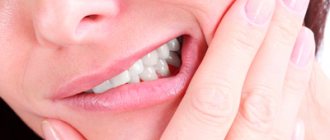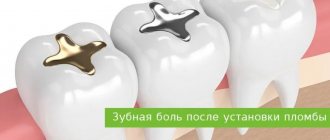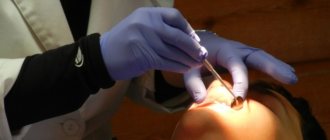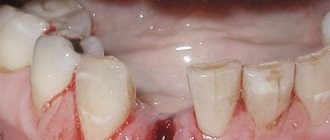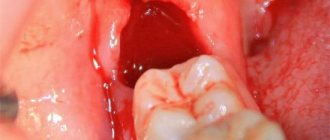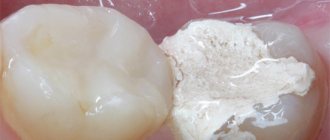Why is the enamel grinding procedure carried out?
Grinding of teeth involves removing a layer of hard tissue (enamel and dentin), so that the orthopedic structure subsequently installed on the “support” looks natural and beautiful, fits tightly, is securely fixed, has stability and strength. This is also done to ensure that microbes do not get under the prosthesis or food debris gets clogged, which together can provoke the development of an inflammatory process.
On a note! Typically, the doctor removes a layer equal to the thickness of the chosen prosthesis. If a crown or bridge is installed, the tooth is ground down to a cone shape. When turning for microprostheses, for example, for veneers, the specialist “cuts down” the enamel in the frontal, lateral and cervical areas.
Often after the procedure, the patient’s gums around the ground tooth hurt, or the prepared element itself ache. Naturally, discomfort does not arise immediately, but after the anesthesia wears off. For some people, discomfort does not appear until several days, weeks or even months later. What is this connected with? We'll figure it out together.
Causes of painful sensations in teeth
1. Physiological response to intervention
This is the most common reason why teeth and gums hurt after grinding for crowns and other orthopedic structures. After all, during the procedure, the specialist acts on the tissue instrumentally and medicinally, touching the nerve endings. This reaction is considered normal.
On a note! If, after grinding teeth, hyperesthesia (increased sensitivity) and aching pain appear, especially during the consumption of cold, hot, sour and spicy foods, and hygienic cleaning, then this often simply indicates a thinning of the tissue area of the prepared unit.
Most often, hyperesthesia after turning occurs on vital, that is, living units where the pulp is preserved. Sensitivity is enhanced even despite the presence of temporary crowns, which, it would seem, serve as reliable protection from external irritants. Temporary structures are fixed immediately after preparation and worn until permanent dentures are created.
Medical errors
If a tooth or gum hurts after grinding, then unqualified actions by the doctor cannot be ruled out. Most often, inexperienced specialists make the following mistakes:
- overheating of the pulp: occurs when preparing tissue with a bur,
- removing too much tissue,
- nerve injury: to avoid complications associated with damage, overheating or inflammation of the nerve under the prosthesis, experienced specialists advise depulping the tooth, that is, first removing the pulp from it.
If the doctor made the mistakes listed above, then the pain makes itself felt almost immediately after the procedure and can persist for several weeks or even months.
3. Development of a pathological inflammatory process
If a lot of time has passed after medical manipulations, and you have severe discomfort and your teeth hurt after grinding for crowns and bridges, then this signals the development of various dental diseases: caries, pulpitis, periodontitis, cyst, granuloma, fistula, abscess, gumboil. In this case, the pain does not go away for a long time, intensifies with each subsequent day, and is poorly relieved by analgesics. Along the way, other alarming symptoms arise: purulent bumps appear on the gums, the gums and cheek swell, the body temperature rises, it becomes painful to chew and press on the causative element.
More often, the problem arises again due to the fault of a clinic specialist who, during the preparation and preparation of tissues before prosthetics, violated the rules of asepsis, did not fully treat (after all, dentures are often placed on teeth destroyed by deep caries and other dental diseases), poorly cleaned and poorly sealed the roots channels. Pulpitis can occur if, in the process of preparing the “support,” the doctor caused irreversible damage to the nerve.
Expert opinion
Andrey Rastislavovich Chernov
Specializations: Orthopedic dentist
Experience: 11+
“Treatment, grinding and prosthetics of a tooth with an orthopedic design is a complex and multi-stage process, in which at least several experienced specialists must take part - a therapist, a dental technician (creates a prosthesis using casts of the jaws), an orthopedic doctor. If everyone has done their job efficiently, then pain after completing all the manipulations should not arise either in the short or long term.”
Sometimes a pathological inflammatory process occurs due to the fault of a patient who systematically violates oral hygiene, does not monitor the condition of installed dentures and surrounding tissues, and receives various injuries.
Causes of pain under the crown
A common cause of problems with teeth under a crown is the negligence of the doctor who performed the prosthetics. The cause of pain may be:
Poor pre-installation procedure
Before placing a crown, the prosthetist must prepare the teeth. Treat root canals, remove nerve endings, fill the canals with fillings. If the pulp was not completely removed, or the filling material does not reach the very top of the root, then pain after installing a metal-ceramic crown cannot be avoided. The same result will be obtained if the canals are not filled tightly during filling.
While grinding a tooth, pain may also occur - when working without proper cooling, the dentist can burn the pulp with an overheated instrument.
Root canal perforation
The doctor may make a mistake when filling the canal - using the expander incorrectly or making a hole when installing the pin for the crown. In this case, an artificially created hole will appear in the root of the tooth, which will subsequently cause pain.
Illiterate prosthetics
During the procedure, there are also frequent cases of errors leading to pain under the crown and inflammation. Especially in cases where the crown is not installed tightly to the gums and teeth. Also, during such work, it happens that the crown comes off due to constant contact of the adhesive with water and food debris.
Careless handling of the tool
Breaking off an instrument for filling root canals or expanding them can lead to the onset of an inflammatory process.
Appearance of cracks
When a crown is cracked, you should immediately seek help, since if you ignore the problem, food particles will get into the holes, which will also lead to pain and inflammation. The service life of a crown ranges from five to fifteen years, so the integrity of the product should be checked at least once a year. This will avoid these unpleasant consequences.
Why does my gum hurt?
Sometimes the teeth do not react at all, but the gums hurt after grinding. Let's list the reasons for this:
- physiological reaction to an anesthetic injection,
- gum retraction: in order to qualitatively fit the prosthesis to the soft tissues and eliminate discomfort during operation, as well as to create a highly accurate design that fully corresponds to all the anatomical features of the patient, before taking impressions, specialists widen the periodontal sulcus. For the procedure, special threads are most often used, which are inserted under the gum and lift it. Such manipulations lead to the fact that the gums then become slightly inflamed and swollen, and also hurt for several days,
- individual reaction of the patient and allergies to the medications used during the grinding process: in this case, the gums may itch and itch, a rash appears on them,
- traumatic gingivitis and periodontitis: if in the process the specialist damaged the gums, then the patient experiences persistent aching pain, swelling and bleeding of the mucous membrane. As a rule, it all starts with gingivitis, but if the disease is neglected, it is complicated by periodontitis.
How is the treatment carried out?
Of course, the simplest option is this: the doctor removes the crown, treats the tooth, and then installs the crown again. But the disadvantage of this method is that the patient will have to pay again for all orthopedic work, including the crown.
However, today you can go a different route, which is offered by some dentists. In this case, the tooth is treated without removing the structure. The doctor makes a hole through which he performs the necessary manipulations, and then seals it.
Before treating a tooth, a photograph is always taken under the crown. If the problem is not detected on the diagnostic image, then the crown will need to be removed to determine the cause of the pain.
Treatment of a living tooth
If the cause is caries, then treatment; most often performed through the crown. Main signs: pain is sharp and severe, the tooth reacts to hot and cold.
If the reason is a violation of the fixation of the crown, then the crown is removed, medicine is applied to the ground tooth, and then the crown is put back.
Treatment of a pulpless tooth
Signs: aching pain, accompanied by pulsation in the temple and ear. Treatment is carried out both with and without crown removal - it depends on the presence of a pin and the cause of pain (periodontitis, a fragment of an instrument in the root, etc.).
Methods of tissue trimming: after which procedures pain occurs more often
There are different ways to prepare tissue. According to experts, after grinding the teeth, some of them may actually experience aching pain. But other methods, on the contrary, are considered gentle, and therefore do not cause discomfort at any stage of treatment and prosthetics.
Using a diamond-tipped bur
The drill, despite the loud, annoying sound, is still popular among dentists, because with its help you can quickly and efficiently carry out work of any level of complexity and scale, and grind off any amount of tissue.
It is boron that is most often used for preparing tissue for crowns and bridges, and for turning teeth for veneers. During the process, the doctor uses the device at different speeds so that it does not cause overheating of the tissues and pulp; at the same time, a cooling liquid is supplied to the oral cavity. Despite all the safety measures, many patients note that it was after using boron that they experienced pain.
Via ultrasound
Situations where a tooth hurts after grinding performed using ultrasound are quite rare. The method is characterized by a more gentle effect, compared to boron[1], allows you to process fabrics carefully and without contact, and does not cause overheating. However, ultrasound can still cause discomfort and short-term increased sensitivity of hard tissues and gums in people with a low pain threshold and weakened enamel.
The method is used if you need to remove a small amount of tissue.
Laser method
Here, a laser is used for preparation, which, like ultrasound, acts in a targeted and non-contact manner. The method is considered one of the safest and most painless[2], suitable for people with sensitive gums and mucous membranes, and does not cause pain or discomfort. The laser not only carefully grinds the tissues, but also disinfects them, promotes rapid healing, and prevents bleeding.
Water-abrasive treatment
Suitable only in cases where a minimum amount of tissue needs to be removed. During the process, a specialist treats the enamel with a stream of water containing abrasive particles. After such grinding of teeth, aching pain and any discomfort are completely excluded.
On a note! Until recently, dentistry also used a chemical method, where tissues were first softened using chemicals and then removed with an instrument. However, today this method is recognized as traumatic and very dangerous for the nerve of the tooth.
Inflammation of a tooth under the crown: symptoms
As we have already said: according to statistics, root canals are filled poorly in 60-70% of cases. The inflammation that occurs in this case under the crown of the tooth is usually manifested by the following symptoms...
Tooth pain under the crown -
Toothache under the crown is usually due to the fact that in the area of the root apex there is a periodontal abscess (focus of inflammation) filled with pus (Fig. 4). The formation of pus leads to tissue distention and pressure on them, which is why toothache appears under the crown. There are often situations when the tooth under the crown hurts when pressing, and there is no pain in the absence of chewing load.
Such symptoms indicate a sluggish inflammatory process. But in some cases, the pain can be very sharp, throbbing, and in parallel, swelling of the gums and soft tissues of the face can occur.
The gums under the crown are swollen, gumboil under the crown is
If you have swelling of the gums or cheeks (Fig. 12), then this is also a sign of the development of inflammation in the area of the apex of the tooth root (Fig. 12). Typically, such swelling appears on the gum precisely in the projection of the apex of the root of the diseased tooth. After the x-ray, the doctor decides on the possibility of saving the tooth and the tactics of its treatment. But in any case, if gumboil occurs, opening of the gums will be indicated to create an outflow of pus.
Fistula under the crown -
Most often, a fistula opening on the gum forms some time after the gums become swollen (Fig. 10-11). The pus that forms at the tops of the tooth root seeks a way out, and as a result, a fistula canal is formed in the tissues, through which the pus flows from the tooth into the oral cavity.
Through this fistula, the pus slowly drains into the oral cavity, and the person swallows it along with saliva. With the formation of a fistula, the acute phase of inflammation always subsides, and the pain decreases or disappears, because there is an outflow of pus. Periodically, the fistula may close, but in this case it will only contribute to the development of a new phase of acute inflammation.
Tooth cyst under the crown –
If the inflammatory process at the root tips has been going on for a long time, then very often on X-rays you can see a dental cyst that has formed. It is a cavity in the bone tissue (in the area of the root apex), which is lined from the inside with a dense fibrous membrane (Fig. 13-14). The cavity contains pus. On the radiograph (Fig. 14), the cyst looks like a dark spot, limited by black arrows, and the unfilled part of the root canal is shown by white arrows.
Symptoms of the presence of a cyst can be: periodic swelling of the gums in the area of the causative tooth, pain when biting on the tooth. But it happens that cysts do not show themselves in any way, and only slowly increase in size. In this case, it can only be determined by radiographs.
Tooth cyst under the crown: diagram, radiograph
If you have any of these symptoms, you should consult a dentist and take an x-ray. Based on the image, the doctor will give you an accurate diagnosis and tell you whether such a tooth can be treated. Remember that toothache under the crown is an important symptom that indicates that something is clearly wrong with the tooth.
How long does the discomfort last?
Many patients are interested in how long their teeth can hurt after grinding. Normally, the unpleasant sensations disappear after 3-7 days. This is the case if the preparation was carried out without removing the nerve, or immediately after depulpation.
According to many experts, long-depulped teeth that have been ground should not hurt at all. If discomfort occurs, it goes away after 1-2 days.
When tissues and nerves are overheated with boron, increased sensitivity can persist for several months. But in any case, pain that intensifies and does not go away for more than one week should be a reason for a visit to the dentist.
What measures to take at home
When your teeth and gums hurt after grinding, it is important to know what to do in this situation. Usually, to quickly eliminate the physiological reaction of tissues to intervention, doctors advise performing the following procedures:
- mouth rinse: you can use chlorhexidine solution, Rokotan. Decoctions of chamomile and sage, which have a calming, antiseptic and anti-inflammatory effect, are also suitable. Rinsing is carried out 2-3 times a day,
- applications: if the gums hurt, it is recommended to apply Solcoseryl ointment to it up to 3-5 times a day,
- taking painkillers from a home medicine cabinet,
- following a gentle diet: in order not to further irritate sensitive tissues, it is necessary to exclude solid, cold and hot foods from the diet. It is better to also give up sour, salty, spicy and sweet foods for a while,
- Carrying out oral hygiene as carefully as possible: if your gums and sharpened teeth hurt, then under no circumstances should you stop performing hygiene procedures. However, to minimize discomfort, you can temporarily switch to a brush with soft bristles and a paste with anti-inflammatory components (chamomile, propolis).
